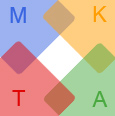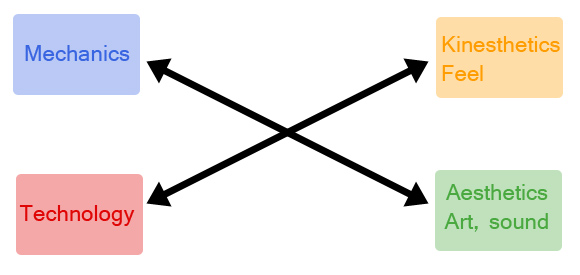
This simple prototyping conceptual tool have served me countless times when approaching a new development in the preproduction phase. It is based in four areas of investigation: Game mechanics, Kinesthetics, Aesthetics and Technology.
The areas are nicely covered in the book Game Design Workshop: A playcentric approach to create innovative games (2nd ed) and the concept was first made public in EricTodd's presentation Spore: Preproduction through prototyping (ppt) at 2006 GDC.
Follow me while introducing this great tool. To start, let's ask: What do I need to prototype?
The areas are nicely covered in the book Game Design Workshop: A playcentric approach to create innovative games (2nd ed) and the concept was first made public in EricTodd's presentation Spore: Preproduction through prototyping (ppt) at 2006 GDC.
Follow me while introducing this great tool. To start, let's ask: What do I need to prototype?
Areas of investigation for the prototyping process
The goal for creating a prototype should always be answering questions on parts of the design that need clarity.
Let's say that I want to know if the story of my game is going to be interesting enough. It's easy to test that, you can telltale it to others or create a short fiction story and see if others are geting excited and engaged with it. But in video game development is so easy to drift to the complex big vision side of things. Then it is when you need to use the PrototypeX to analyze your prototyping efforts.
There are four main areas in which we can fit that question that we need to solve:
Game mechanics: the formal aspect of the game. Winning, losing, economies, etc. It sometimes involved mathematics.
Kinesthetics: The game feel. Idea is that the interface is an extension of your body into the game world. How does the whole experience feels? According to Steve Wink, game feel components are: Input, response, context, polish, metaphor and rules.
Aesthetics: Mostly talking about visual and aural aesthetic. That's visual art, music and sounds.
Technology: During preproduction you’re reducing risk and if you’re doing something new, some of that risk is technical. Prototyping technology is about getting answers to successfully implement gameplay concepts or production workflow proccesses.
Let's say that I want to know if the story of my game is going to be interesting enough. It's easy to test that, you can telltale it to others or create a short fiction story and see if others are geting excited and engaged with it. But in video game development is so easy to drift to the complex big vision side of things. Then it is when you need to use the PrototypeX to analyze your prototyping efforts.
There are four main areas in which we can fit that question that we need to solve:
Game mechanics: the formal aspect of the game. Winning, losing, economies, etc. It sometimes involved mathematics.
Kinesthetics: The game feel. Idea is that the interface is an extension of your body into the game world. How does the whole experience feels? According to Steve Wink, game feel components are: Input, response, context, polish, metaphor and rules.
Aesthetics: Mostly talking about visual and aural aesthetic. That's visual art, music and sounds.
Technology: During preproduction you’re reducing risk and if you’re doing something new, some of that risk is technical. Prototyping technology is about getting answers to successfully implement gameplay concepts or production workflow proccesses.
As a general rule, the most the prototype focuses on one of this four areas more quickly and straight the answers will be. When the design questions get more complex some of the answers may be found in prototypes that explore the relation between two of this areas. For that cases avoid researching the two areas in the same line at the same time.
There certainly more cases in which to use the PrototypeX to analyze more complex, and real, preproduction situations. That's for a future post as well as some juicy examples.
There certainly more cases in which to use the PrototypeX to analyze more complex, and real, preproduction situations. That's for a future post as well as some juicy examples.
A note on the prototyping medium
Before starting a digital prototype from scratch consider all the other resources and options available to put your question to the test: Physical objects, toys, pen and paper, people, people following orders, modded games, roleplaying. The list has no end. What you need is to recreate only the bits of the experience that give you the information you need.
What's the most unusual prototype medium you can think of? Which of the four areas would it be exploring?
What's the most unusual prototype medium you can think of? Which of the four areas would it be exploring?


 RSS Feed
RSS Feed
